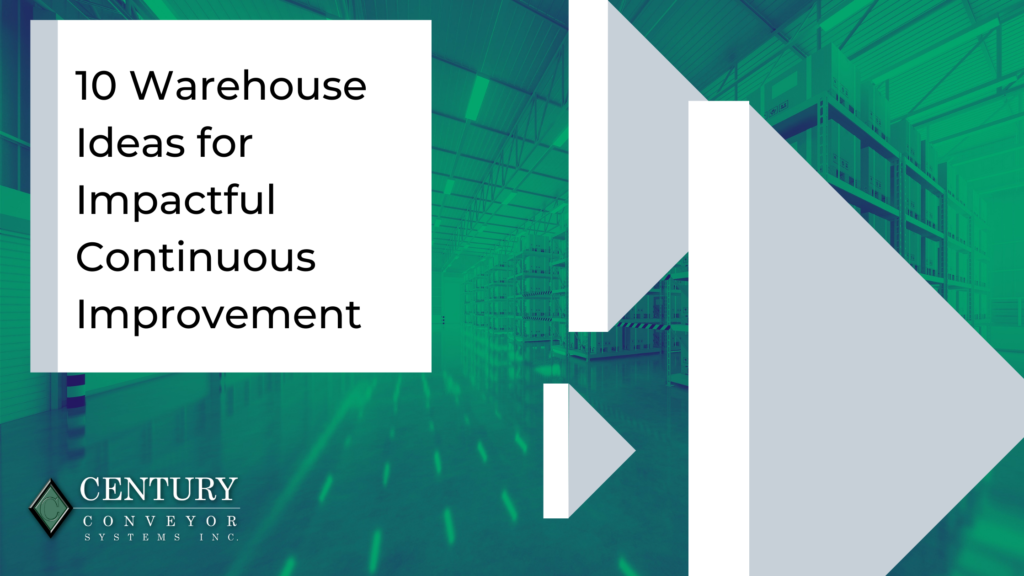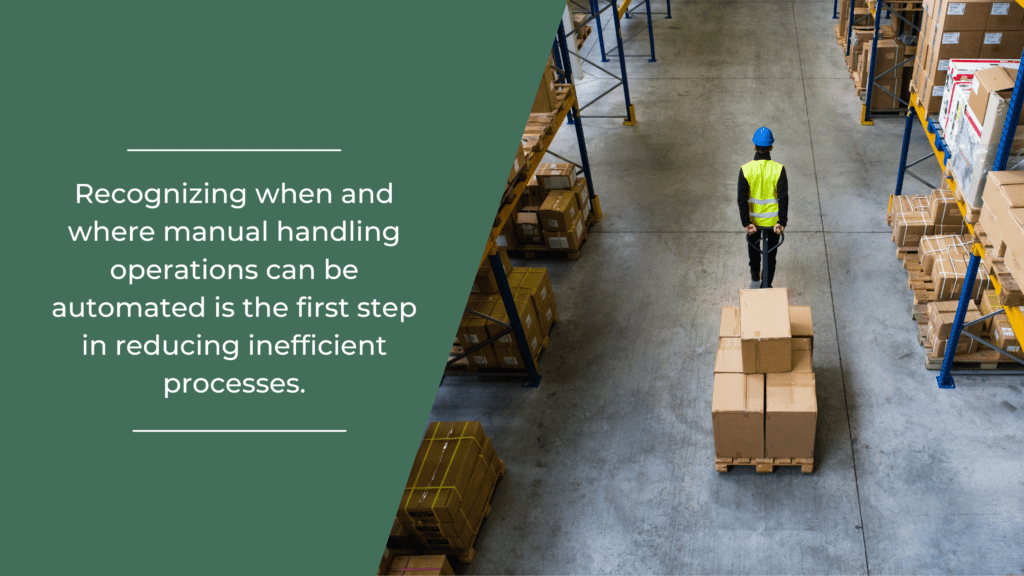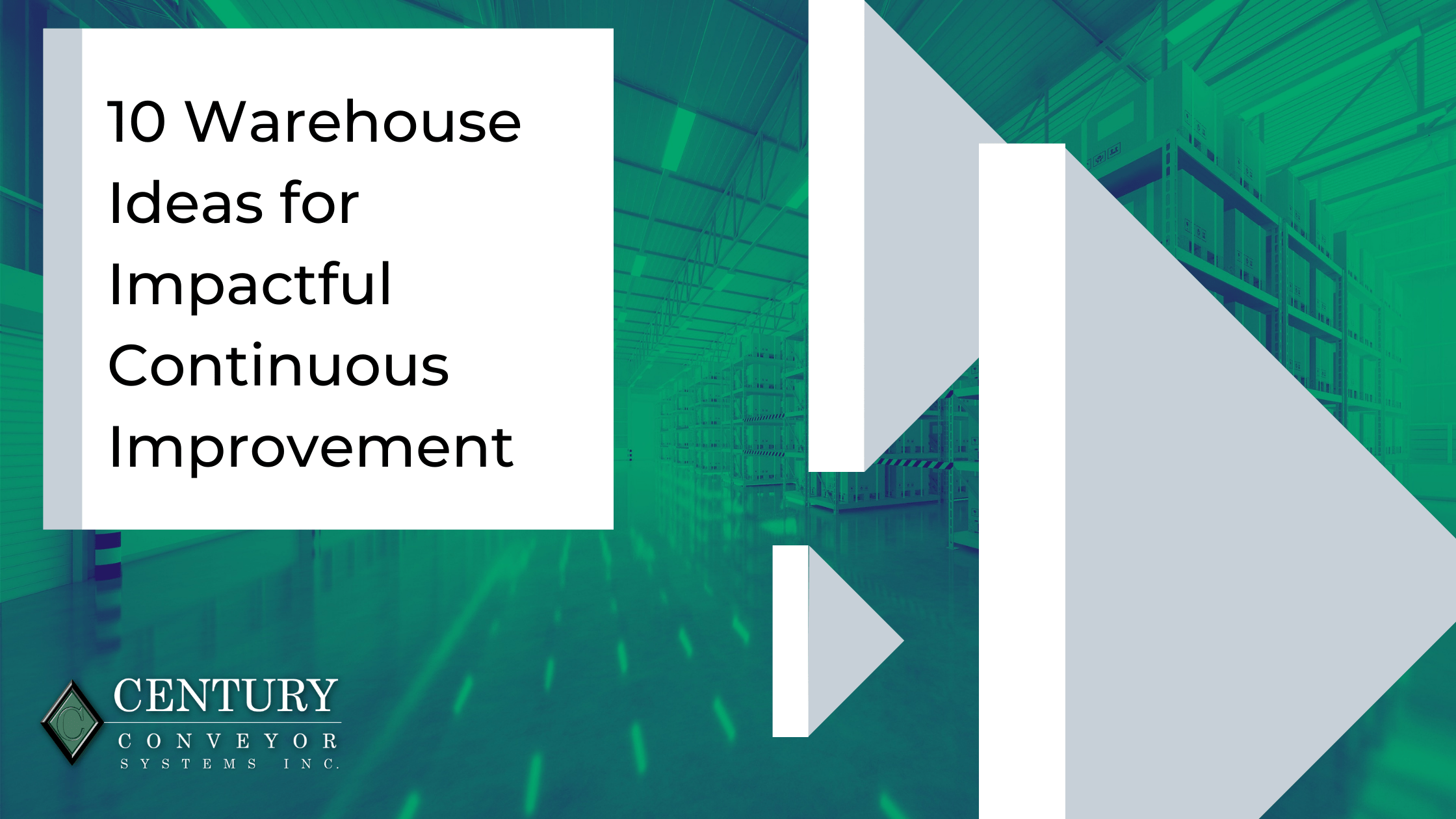
The job of a continuous improvement professional is a multi-variable logistical nightmare, and typically they’re juggling multiple processes and implementation projects at once. A warehouse, whether used for manufacturing, storage, distribution, order fulfillment, or all four, is an integral point of the supply chain where many continuous improvement and operational excellence professionals (like yourself) focus on.
Century Conveyor Systems has over 40 years of working with warehouse operations and understands where streamlining tactics can be administered. Here are our 10 insightful ideas to generate positive warehouse performance.
1. Real-time warehouse visibility
Real-time visibility into warehouse operations through HMI (human-machine interface) will give you valuable control and insight into day-to-day product movement. Allowing warehouse employees detailed error notification, showing the status in all areas of the system, and providing remote access to all control stations located on a system are just three of the major benefits of an HMI.
Adding or updating an HMI program to any automated system immediately begins to increase productivity within a facility, and HMI programs give the warehouse employees a much easier approach to operating an automated system effectively.
2. Evaluate communication channels
How do your warehouse workers communicate with each other (if, at all?). A growing solution that many warehouses are adopting is providing communication methods for employees. This could be as simple as walkie-talkies or as integrated as a voice-to-pick system that prompts employees on picking operations.
Effective communication also extends to project managers. While the typical array of emails, video meetings, and phone calls are here to stay, ERP solutions can integrate direct messages based on specific projects, timelines, and areas of focus. SAP and Oracle are common platforms, but more focused ones like Jira can be implemented as well.

3. Effective waste reduction
Environmental awareness should be an area of continuous improvement for any warehouse. Whether it’s distribution or manufacturing, waste is a byproduct of the operation and must be disposed of or repurposed quickly and effectively.
The most common form of waste disposal is a baler, which typically compresses packaging refuse (like corrugate or plastic). For operations that produce a larger amount of waste, a trash conveyor can move waste into a baler, so all workers must do is move their trash to the line as it automatically takes it away.
4. Maximizing warehouse space usage
Warehouse space is extremely precious-ensuring there’s room for storage, order fulfillment, loading, maintenance, employees, and office space- all while following building codes, is no easy feat. If space is at a premium, but additional systems will need to be implemented in the future, a few capacity-saving solutions can provide some leeway.
- Inclined and spiral conveyors
- Suspended conveyor sections above the warehouse floor.
- Mezzanine structures
- Walkways and platforms suspended above the warehouse floor.
- Narrow-aisle racking
- Special forklifts can be used to access pallets in these lanes
- ASRS
- Automated cranes travel within narrow-aisle racking structures to retrieve pallets
- Shuttle system
- Items are held in compartments within a complete racking structure, eliminating aisles completely.
If there are warehouse constraints you’re aware of, it may be time to complete a cost-analysis of keeping existing structures or replacing them with space-saving solutions.
5. Influence performance in partners
Transparency and a reporting cadence among partners are key to ensuring your process improvements extend outside of the warehouse. Whether it’s a third-party logistics company that cross-docks your products, or a trucking broker that provides delivery to retail stores, you should be informed of their performance like they’re your own employees.
Many partners provide data reporting software that’ll integrate into your WMS or send automatic updates via an internal portal or email. Review this data and ask questions on any discrepancies, sharing thoughts on where improvements could be made. Fostering open communication and knowledge will benefit both you and your partners and generate performance across the entirety of the supply chain.

6. Reduce manual labor redundancy
Repetitive manual tasks within a warehouse can be a significant profit drain, especially when finding reliable labor is difficult. Although a more expensive upfront cost, automating such tasks quickly pays itself back and outpaces manual operations in every aspect.
As an example- manual box erecting requires at least one employee (more if it’s a 24-hour warehouse) to simply fold and form boxes all day. An automatic case erector can replace inefficient repetitive laborers, and far outpace their output and associated costs. There are many automated solutions, and each has different benefits and functionality. Century can help you navigate and engineer a system that’ll boost every aspect of your continuous improvement efforts. Let us know about what you’re working on, and we’ll be happy to share our experience.
7. Spur team collaboration
A term you may have heard before, a kaizen process is the idea that employees from all levels of a company can collaborate together to provide insights and skills in the pursuit of incremental improvement.
Every employee works on a specific touchpoint in your warehouse and most likely has deeper knowledge on whatever they manage the most. In this sense, they can provide expanded details that when rectified, can impact the overall process positively.
For example, a maintenance director may know which systems experience the most downtime, and why. Opening lines of communication and collaboration between different departments can solve inefficiencies that wouldn’t have been recognized otherwise.
8. Integrate a powerful WMS platform
The ability to have complete visibility of your warehouse inventory at all times is paramount to operating effectively. A warehouse management system (or WMS) stores vital information such as batch number, storage location, inventory quantity, and a multitude of SKU data for ordering. A WMS can even offer the best shipping rate selector and presents data with specific handling information (like weight and dimensions).
Besides being a source of important product information, a WMS can apply that information within your warehouse operations. For example, if the wrong item is picked and placed on an outbound conveyor, the scan tower will read the label and the WMS will recognize it is in the wrong batch, stopping that section of conveyor and sounding an alarm for a worker to remove the incorrect item.
9. Follow supply chain technology developments
As a continuous improvement professional, you should be aware of new developments in supply chain and warehouse technology. Solutions are becoming more nuanced in the sense that there is very specific functionality it provides, which could offer a potent process improvement if applied correctly.
The best way to stay up to date is by setting up a collection of RSS feeds that gathers news and press release articles from industry-leading websites. RSS.app is a great RSS program to start with. Checking your feeds on a daily basis keeps you in the know and allows you to be a proactive supply chain executive.
10. Establish and compare KPIs
Most importantly, before any continuous improvements are implemented, benchmarking has to be done to validate the cost-benefit and efficacy of your strategies. Identify the implementation points in the warehouse and compare output rates over a certain timeframe.
Coordinate with an engineer or plant manager on the system rates of any solutions used, and set goals on where you’d want those rates to be. Many reporting platforms offer KPI settings to collate data around a preselected criterion. Fine-tune these settings to identify inefficient warehouse touchpoints and explore solutions on what would solve them, while maintaining a positive ROI.




